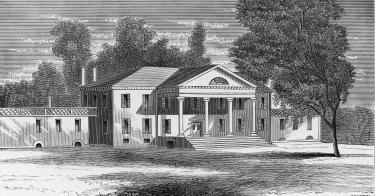In the past few months, I have written much about James Madison’s Montpelier, our fourth president’s home and now museum. A great deal of my writing has been descriptive, detailing the exhibits at Montpelier and evidencing whose influence has been impactful. I piled fact upon fact, relying on research and primary sources and letting much of my report speak for itself. It is primarily (though not exclusively) what is missing, rather than what is there, that I find troublesome.
Missing Is Madison
James Madison was the Father of the Constitution. We use this label in passing (as do the tour guides at Montpelier), but often do not reflect on what it means. Madison was the primary author of the Bill of Rights and penned many of “The Federalist Papers.” At the age of 36, he was perhaps the most essential delegate at the Constitutional Convention (others will argue for George Washington or James Wilson).
Madison was the man with the Virginia Plan. Prior to the convention, he poured over writings and examples of ancient and modern confederacies, trying to figure out a way to make America work as a republic. He offered his solution: a system of checks and balances, separation of powers, and federalism. These precautions form so much of how America operates today that we don’t even think about them—because Madison thought about them for us.
Some of these accomplishments are discussed during a brief video in the visitors center and a portion of the house tour, but no exhibits focus on Madison. This is woefully insufficient for so remarkable a man and document.
Missing Are Important Facts
An exhibit panel in the cellars shows pictures of the first 18 presidents with descriptions of their relationships to slavery, sometimes affirming that a given president never freed his slaves. It does not detail that George Washington, upon Martha’s death, freed those he could through his will. John Adams’ description reads that he never owned slaves, but “some of his legal clients did.”
Montpelier contends that the “economy of slavery permeated every state” and 80% of all U.S. exports produced in 1860 were a result of slave labor. They do not note, as Phillip Magness does in “The 1619 Project: A Critique,” that exports were a small part of gross domestic product during that time and cotton output was 5%-6% of the antebellum economy. The 1619 Project makes similar claims to Montpelier, taking them even further, to taint capitalism itself.
The exhibit on slavery and the Constitution explains that “slavery” or “slave” never appears in the Constitution but doesn’t explain that this was deliberate on the part of the delegates at the convention. Not recognizing property in men was the constitutional basis that, in time, led to the elimination of slavery, as demonstrated by Sean Wilentz in “No Property in Man: Slavery and Antislavery at the Nation’s Founding.”
Another panel highlights the domestic violence and insurrection clauses of the Constitution, insinuating those clauses were about slavery. Just two of the five slave revolts listed occurred before the Constitution was written, so only those two could have influenced its text.
The panel does not mention that many of the delegates had in their minds Shays’ Rebellion, a calamity that happened a few months prior to the convention, which had nothing to do with slavery. It involved 1,500 people who seized control of the roadways in Massachusetts in order to protest the collection of taxes.
Missing Are Madison’s Words
Madison wrote that the delegates at the convention refused to enshrine “slave” or “slavery” in the Constitution because they “thought it wrong to admit in the Constitution the idea that there could be property in men.”
He, along with others, said Shays’ Rebellion was the impetus for the convention, as it had shown “new proofs of the necessity of such a vigour in the Genl. Govt. as will be able to restore health to any diseased part of the federal body.”
His words are missing in his own house.
Missing Is American Accomplishment
In the cellars of Montpelier is a contemporary video contending that there are more defeats in American history in pursuit of fairness, justice, and equality than there are moments of triumph. This is a portrait of an America I do not recognize.
It diminishes not only the contributions of the Founders, but of generations of Americans who moved us toward a fuller realization of our principles.
Is not the deft statesmanship and unshakable integrity of Abraham Lincoln ours to claim? What of the unflinching conscience, made arresting in its eloquence and truth, of Harriet Beecher Stowe? Or the quiet resolve of countless everyday-yet-exceptional Americans who honored us with the lives they lived, some of whom gave their very lives?
Yes, we have had our failures and lamentable contradictions (slavery being the most heartbreaking of them), but America’s triumphs include the cord that links the hearts of liberty-loving men and the miracle of Philadelphia: our Declaration of Independence and our Constitution. These two documents are tremendous contributions to the cause of human freedom.
All This Leaves Us Missing Gratitude
By focusing almost exclusively on grievance rather than our shared accomplishments, Montpelier is depriving men and women of proper pride and dignity. Dwelling in resentment is not what we teach our children, as it will not make them strong, gracious, and dignified.
Nor will it unite Americans. Part of the American story is the horrid truth of the oppression of a people based on the “mere distinction of colour,” as Madison said. But that is not the whole truth—far from it— or the end of the story. The American story is one of collective determination, grit, and defiant confidence of a single people, not defined by ethnicity, who dared to believe in self-government.
This is the part of the American story that is triumphant—and until now at least—has been the main theme, just as it is the unfinished theme. The American story is not complete. What will be written in the months and years ahead will depend on whether Americans choose to emphasize victimization, resentment, and retaliation; or choose instead to remember more of the good than the bad, that we may continue in our shared vision of human freedom and the precepts of justice, bound together by civic friendship.
To Madison and the Founding generation we owe a debt of gratitude for the sacrifices they made so that future generations of Americans might live in freedom, replete with the opportunity to demonstrate to the world, and to themselves, that human beings are in fact capable of governing themselves.
On an early page of this story, we find an illustration of Madison sitting in his library at Montpelier looking toward vast rolling hills and mountains, hoping that his new nation would long endure. Not content to abandon our project to cruel fortune, he left for us a guide, etched on a piece of yellow parchment, that still keeps watch today. That parchment should stand in prominence at Montpelier.
This piece originally appeared in The Daily Signal




